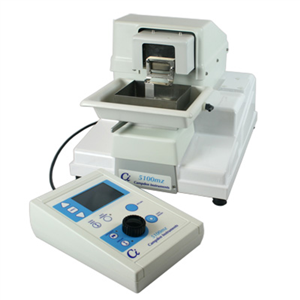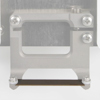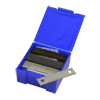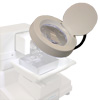

5100mz
The standard 5100mz shares the User interface with the premium 7000smz-2, placing a wide range of adjustable parameters at the user’s fingertips:
- Overview
- Specifications
- Accessories
- Citations
- Related Products
Overview

There are 1 images available to view - click to enlarge and scroll through the product gallery.
Instruction Manual
/ Download as PDF
The New 5100mz shares the User interface with the premium 7000smz-2, placing a wide range of adjustable parameters at the user’s fingertips:
- Vibration frequency from 50 to 80 Hz
- Adjustable amplitude from 0.5mm to 1.5mm
- Fine control of the blade advance (min. 0.1 mm/sec)
- Set start and finish position of blade travel
- Remote controls allowing for sterile use in culture hood
- Ice water bath easily removed for cleaning
- Optional cold light and magnifier for clear observation
- Optional Peltier cooled bath
Use in fully manual or the semi-automated "Slice window" mode which automatically remembers the start and finish position of the slice. This New entry-level Microtome is perfect for techniques such as histology, organotypic slice culture and low resolution imaging with a fixed blade holder and a mechanism Z axis error of ≈ 5-8µm.
Specifications
| Section thickness step size: | 0.001 mm |
| Bath table rise & fall speed: | 1.0 mm/sec maximum |
| Maximum (vertical) travel of bath table: | 19 mm |
| Cutting head advance speed | Minimum: -2.0 mm/sec (-1.00 during slicing) Maximum: +2.0 mm/sec (+1.00 during slicing) |
| Cutting head retraction speed: | 2.0 mm/sec |
| Maximum travel of cutting head: | 40 mm |
| Blade oscillation frequency | Minimum: 50 Hz Maximum: 80 Hz (amplitude dependent) |
| Frequency step size: | 5 Hz |
| Blade oscillation amplitude | Minimum: 0.5 mm (nominal) Maximum: 1.5 mm (nominal) |
| Amplitude step size: | 0.5 mm (nominal) |
| Power requirements (Selectable): | 115VAC 60Hz, 230VAC 50Hz |
| Power rating: | 100W |
| Fuse rating (115V): | T2A 250VAC |
| Fuse rating (230V): | T2A 250VAC |
| Light source: | Powered from 5100mz |
| Dimensions: | 350mm Width x 450mm Depth x 350mm Height (excluding magnifier/light source) |
| Weight: | 15kg (excluding magnifier) |
| Boxed shipping weight: | tba |
Accessories
7550-1-C
Specialized Ceramic blades for Vibrating Microtomes. These blades are honed with a sing...
7550-1-SS
Stainless Steel Blades - 50 pack;Recently redesigned following customer feedback and ap...
5100-1-3
Integrally Mounted Cold Light Source and Magnifying GlassA magnifying glass for general...
Citations
Ahumada, J., Sevilla, D., & Couve, A. (2013). Long-term depression of inhibitory synaptic transmission induced by spike-timing dependent plasticity requires coactivation of endocannabinoid and muscarinic. …. Retrieved from https://onlinelibrary.wiley.com/doi/10.1002/hipo.22196/full
Cymerblit-Sabba, A., Schiller, M., & Schiller, Y. (2013). Termination of Chemoconvulsant-Induced Seizures by Synchronous and Asynchronous Electrical Stimulation of the Hippocampus In-Vivo. Brain stimulation. Retrieved from https://www.sciencedirect.com/science/article/pii/S1935861X13000880
Graupner, M., & Reyes, A. (2013). Synaptic Input Correlations Leading to Membrane Potential Decorrelation of Spontaneous Activity in Cortex. The Journal of Neuroscience. Retrieved from https://www.jneurosci.org/content/33/38/15075.short
Jang, H., Cho, K., & Kim, M. (2013). Layer-and cell-type-specific tonic GABAergic inhibition of pyramidal neurons in the rat visual cortex. Pflügers Archiv-European …. Retrieved from https://link.springer.com/article/10.1007/s00424-013-1313-1
Lao, C., Lu, C., & Chen, J. (2013). Dopamine D3 receptor activation promotes neural stem/progenitor cell proliferation through AKT and ERK1/2 pathways and expands type-B and-C cells in adult. Glia. Retrieved from https://onlinelibrary.wiley.com/doi/10.1002/glia.22449/full
Li, Y., & Wang, J. (2013). Membrane Insertion of New AMPA Receptors and LTP Induced by Glycine is Prevented by Blocking NR2A-Containing NMDA Receptors in the Rat Visual Cortex In. Current neurovascular research. Retrieved from https://www.ingentaconnect.com/content/ben/cnr/2013/00000010/00000001/art00009
McGee, T. (2013). Copper block of extrasynaptic GABAA receptors in the mature cerebellum and striatum. The Journal of …. Retrieved from https://www.jneurosci.org/content/33/33/13431.short
Moon, Y., Kim, J., Kim, W., & Kim, H. (2013). Function of Ezrin-Radixin-Moesin Proteins in Migration of Subventricular Zone-Derived Neuroblasts Following Traumatic Brain Injury. STEM …. Retrieved from https://onlinelibrary.wiley.com/doi/10.1002/stem.1420/full
Revest, J., & Roux, A. Le. (2013). BDNF-TrkB signaling through Erk1/2MAPK phosphorylation mediates the enhancement of fear memory induced by glucocorticoids. Molecular …. Retrieved from https://www.nature.com/mp/journal/vaop/ncurrent/full/mp2013134a.html
Uribe-Querol, E. (2013). Selective and constructive mechanisms contribute to neural circuit formation in the barrel cortex of the developing rat. … in Bioscience & …. Retrieved from https://search.ebscohost.com/login.aspx?direct=true&profile=ehost&scope=site&authtype=crawler&jrnl=21568456&AN=91607134&h=noLPbvB7DEJIriMau8lqkyoHiQp1klni4UHg%2Ba3TqUbYgzHQxJLUjF1ZbOHbPfemVvSfKz2wuHUBoEq%2BiQQ%2B8w%3D%3D&crl=c








Request
Catalogue
Chat
Print